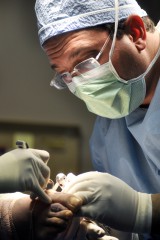The month of October makes most people think of pumpkin spice lattes, vibrant leaves, and Halloween costumes. But here at Premier Orthopaedics, we have something else we keep an eye out for, too, because it's also the time of year known as National Spine Health...
LATEST BLOGS
September is National Vascular Disease Awareness Month
As September starts, it's National Vascular Disease Awareness Month. This is a great time to learn about the health of our veins and arteries. Vascular diseases include problems like deep vein thrombosis and peripheral arterial disease. Read on to learn how to keep...
Causes & Treatment Options for Sciatica
Pain that starts in the lower back and radiates down the back of the leg is what is commonly referred to as sciatica. The pain follows the path of the sciatic nerve down the leg which means that typically, only one side of the body is affected. The sensation that...
Bunions: Causes, Symptoms and Solutions

Bunions cause a lot of pain and stiffness, make it difficult to walk, impair the function of the foot, and make wearing shoes nearly impossible.
Fortunately, there are simple methods to treat bunions and relieve pain. Keep reading for more information on how you can get pain relief from your bunion.
What is a bunion?
A bunion is a deformity of the first metatarsophalangeal (MTP) joint at the base of the big toe. A bunion forms when the first metatarsal bone of the foot turns outward and the big toe points inward. This causes the joint to protrude rather than line up with the toe and look like a bump on the foot.
We exert a lot of force on the joints of our feet during daily activity, and when more force than usual is put on our joints, it can cause instability that leads to deformities. Consistent pressure on the MTP joint over a long period of time can cause bunions.
Causes
There are some foot types that are more prone to developing bunions. Bunions are not hereditary, but foot types are passed on from one generation to another. Feet that function abnormally, are flat, or have low arches are more prone to developing bunions.
People who are on their feet all day long, day after day, place a lot of stress on their feet.
Wearing shoes that don’t fit appropriately, especially when the toes are crammed in without any room to move, can also cause bunions. Bunions are more prevalent in women, due to uncomfortable shoes such as high heels that women wear on a daily basis.
Symptoms
Most people who develop bunions can typically identify them when they start to form. The following symptoms are signs that you have a bunion:
- A firm bump on the outside at the foot at the base where the big toe starts to form
- Pain and restricted motion of the big toe
- Redness, swelling, or pain at the MTP joint
Treatment
For mild pain, there are ways to treat your bunion at home for relief. Apply an over-the-counter bunion pad from the pharmacy around the protruding area and avoid high heel shoes to prevent more pain. If your bunion becomes swollen, apply ice packs to reduce inflammation.
If your bunion continues to be painful, visit a physician for professional treatment. The treatment will depend on your foot and the severity of the bunion. Your physician may suggest the following treatments:
- Padding and Taping – Padding the bunion reduces pain and taping keeps the foot in a normal position, minimizing stress on the area.
- Medication – Over-the-counter anti-inflammatory medication and cortisone injections are often recommended to reduce pain and swelling
- Orthotics – Orthotics are shoe inserts worn to reduce pain caused by the bunion and to prevent the symptoms from getting worse.
- Surgery – If these non-operative methods have not been effective in reducing pain, your physician may suggest surgery. To repair the toe joint, the surgeon will remove the enlarged portion of the bone and restore the normal alignment of the join.
If you’re dealing with a painful bunion, these methods can help. Be sure to speak with a physician if you are unable to find relief with home treatments. If you’re undergoing bunion surgery, it’s important to have a reliable surgeon. Download our e-book, How to Choose an Orthopaedic Surgeon, for more information on how to find the right surgeon for you.


